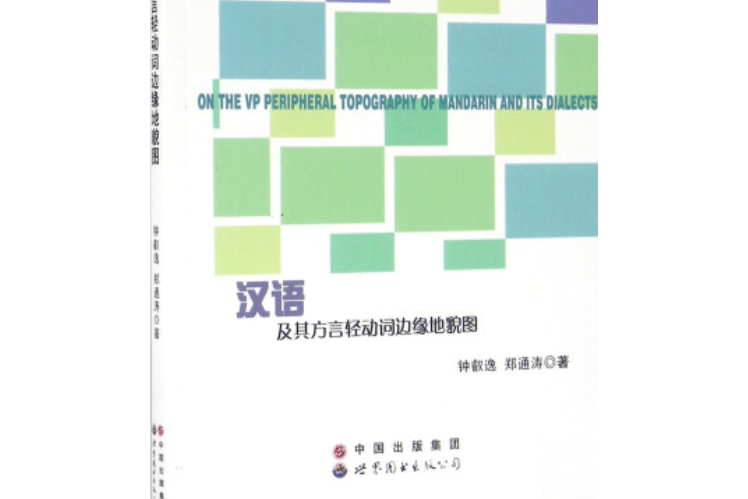《漢語及其方言輕動詞邊緣地貌圖》是2016年世界圖書出版公司出版的圖書,作者是鐘叡逸、鄭通濤。
基本介紹
- 中文名:漢語及其方言輕動詞邊緣地貌圖
- 作者:鐘叡逸、鄭通濤
- 出版時間:2016年1月1日
- 出版社:世界圖書出版公司
- ISBN:9787519209353
- 開本:16 開
- 裝幀:平裝
內容簡介,圖書目錄,
內容簡介
《漢語及其方言輕動詞邊緣地貌圖》主要研究漢語與方言輕動詞特徵的對比,利用比較語法研究法法、製圖理論,以方言作為線索,梳理非典句式中的條理,探索客語的輕動詞邊緣,最終提出一幅地貌圖,幫助讀者掌握其句法特性以及相應的語義詮釋。最終鋪排客語輕動詞邊緣地貌圖,以期清晰地掌握輕動詞邊緣,並同時進行跨語言比較,藉此突顯個別語言的特色,點明語言之間的通則和個性。
圖書目錄
CHAPTER 1 INTRODUCTION
1.1 Background: the Hakka Dialects
1.2 The Theoretical Background: the Cartographic Approach
1.2.1 Three - Layer Configuration
1.2.2 A Rigid and Invariant Universal Structure
1.2.3 Cartography and Minimalism
1.3 Research Issues and Questions: Cartography of vP Periphery in Hakka
1.3.1 Argument Structures
1.3.2 Syntactic Hierarchy and Sentential Linearization
1.3.3 Cartographic Approach in Analytic Languages
1.4 Blueprint of Thesis
CHAPTER 2 THE DISPOSAL CONSTRUCTIONS IN HAKKA
2.1 Introduction: Disposal JIONG versus BA
2.2 Literature Reviews
2.2.1 Hakka Disposal Construction:
2.2.2 Chinese BA Construction
2.2.3 The Development of Jiang 將 Construction
2.3 Two Types ofjiong Constructions in Hakka
2.3.1 Optional/Obligatory Possession & Inalienable NP
2.3.2 Two Types of fiong: Disposal and Affective
2.4 The Proposal
2.4.1 The Locus and the Structure
2.4.2 Jiong- Construction in a Broad Perspective
2.4.2.1 Co -occurrence: Supporting Evidence for Distinct Syntactic Position
2.4.2.2 Cross - linguistic Comparison : Disposals and Affectives
2.4.3 Affectedness
2.5 Conclusion
CHAPTER 3 THE AFFECTIVE CONSTRUCTIONS IN HAKKA
3.1 Introduction: Extra -Argument Licensing
3.2 Literature Reviews
3.2.1 Bipartite Applicatives ( Pylkkanen 1999, 2002 ; McGinnis 2001, 2005 )
3.2.2 Tripartite Applicative Constructions (Tsai 2007, 2009, 2011 )
3.3 Two Types of Affective Constructions
3.3.1 Basic Facts
3.3.2 The Nature of tung
3.3.2.1 Cantonese tung ( Matthews and Yip 1994 ; Matthews 2006 ; Tang 2009 )
3.3.2.2 Hakka tung
3.3.3 Inner Affective Constructions : Pseudo - DOC & tung - construal
3.3.4 Outer Affective Constructions : tung Construals
3.3.5 The Proposed Structure of the Hakka Affective Constructions
3.4 The Argument Introducers
3.4.1 Possible Introducing Strategies
3.4.2 Case Study : fiong - Affectives and tung - Affectives
3.5 Conclusion
CHAPTER 4 THE AFFECTIVES IN BROAD PERSPECTIVES
4.1 Introduction: the Picture of Affeetive Constructions
4.2 Interactions with vP - Peripheral Elements
4.2.1 Light Verbs and Affeetives
4.2.2 Adverbials and Affeetives
4.2.3 Intermediate Summary
4.3 Multiple Affectives
4.3.1 The Combinations: Marked + Marked/Marked + Unmarked
4.3.2 The Proposed Structure
4.4 Affectives and Disposals
4.4.1 Ka -Hoo constructions in Taiwan Southern Min
4.4.2 The Combinatin : Affective ( tung, pseudo - DOC) & Disposal (fiong,)
4.4.3 Proposed Structure : the Topography of the vP Periphery
4.5 The Grammatiealization : the origin of Affective constructions
4.5.1 A Coincidence Perspective (Tsai et al 2008)
4.5.2 What an Affective Construction can be?
4.6 Conclusion
CHAPTER 5 THE POSTVERBAL MODAL PROJECTIONS IN HAKKA
5.1 Introduction
5.2 Literature Reviews
5.2.1 Postverbal Modals
5.2.2 The Syntax of Complex Heads
5.3 The Proposal: Three Types of TET Construction
5.3.1 The Nature of tet: an Affixal Modal
5.3.2 Two Procedures/Strategies: Move and Merge
5.3.3 (A) symmetries among Three Types of tet
5.3.4 Intermediate Summary
5.4 Tet in Comparative Perspectives
5.5 ZOTET : zo - tet ( v - Mod) to ZOTET
5.6 Conclusion
CHAPTER 6 VP PERIPHERAL AREA IN HAKKA
6.1 Introduction
6.2 Interactions within vP - Peripheral Elements
6.2.1 Modal tet and Adverbials
6.2.2 Modal tet and Light Verb Construals
6.2.3 Modal tet and Affective Constructions
6.2.4 Intermediate Summary
6.3 Cross - linguistic Comparison
6.3.1 Modals
6.3.1.1 Mandarin Chinese : modality and subject specificity
6.3.1.2 Modal tet in Hakka dialects
6.3.2 Argument Arrangement
6.3.2.1 Disposals
6.3.2.2 Affectives
6.4 The Topography of Peripheral Area
6.5 Conclusion
REFERENCES
APPENDIX: THE LIST OF ABBREVIATIONS

